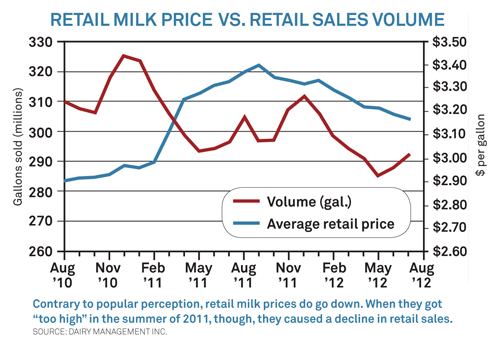Market Watch Diary: Milk Price Can Get ‘Too High’

 Before you chase the messenger off your farm, please listen to the message.
Before you chase the messenger off your farm, please listen to the message.
You have been in a horrific cost-price squeeze for the better part of four years. You suffered through unreasonably low milk prices in 2009. You gained a little traction in 2010 and saw a nice bump in milk prices in 2011.
Then milk prices collapsed again, right into recordshattering feed prices—that is, if you can find feed.
A significant number of your customers haven’t had it much better. Millions of Americans are unemployed. Countless others are underemployed. They have been flipping burgers at McDonald’s and scrambling to feed their family instead of building houses or working on an assembly line. There is a light at the end of tunnel, but this economic recovery is still a work in progress.
Recession or not, economics tells us that there is a limit to how much consumers will pay for things—milk and dairy products among them. Yes, people need to eat, but today they have a lot of options.
|
| |
If the beef price is perceived as "too high," they eat macaroni and cheese. If cheese looks "too high," they will eat meatloaf.
Ditto when it comes to beverages. Literally hundreds of beverages are vying for the attention of consumers.
More than just price is being considered, but the fact remains that higher milk prices trigger a reduction in milk sales at the grocery store.
In fact, there was a 59% correlation between retail milk prices and milk sales volumes over the past two years, according to a statistical analysis of the best available data from Dairy Management Inc.
The chart below helps to illustrate this, and the point has been made repeatedly in academic and industry analyses of the relationship between milk prices and milk sales. Studies that cover decades of data come to the same conclusion.
Price volatility, in my humble opinion, also has a negative impact on milk sales. Through the peaks and valleys of Class I milk prices over the past several years, retail milk sales have established a very clear trend: they move lower month after month, almost without interruption.
Take another look at the chart. Contrary to popular perception, retail milk prices do go down. In fact, the correlation between farm milk prices and retail milk prices over this time frame came in at 69%. Unfortunately, a great deal of damage was done during the summer of 2011, when the Class I mover was above $20 for four consecutive months.
Bottom line: The retail milk price can and does get "too high," taking a bite out of sales.








